Croatia part 3. Grasevina, Plavac Mali and the best restaurant in Istria.
POSTED ON 16/08/2009I was pleased to see recognition for Croatia in the Telegraph online today. The article underlines the growing importance of this exciting wine country and I feel sure that once the UK wine trade has got its head around just how good these wines are, we’ll start to see a Tesco Finest Graševina, an Asda Extra Special Malvazija and a Sainsbury’s Taste the Difference Plavac Mali. On second thoughts, don’t hold your breath.
Now where was I? Ah yes, the third instalment of my Croatian idyll, starting with a blow-out meal at what’s surely Istria’s finest restaurant, and then two tastings, one of graševina, aka riesling italico, and the other of plavac mali, the grape that’s now known to be related to zinfandel.
Serving the wine at the impressive San Rocco restaurant (www.san-rocco.hr). in Brtonigla, Istria, Teo Fernetich gives us an idea of just what a cultural and ethnic melting pot this beautiful heart-shaped peninsula region in Croatia’s north-west is. ‘My great grandfather was Austrian, my grandfather Italian, my father Tullio is Yugoslav, me I’m Croatian, and we’ve all lived here in the same house’. As became clear from the welcoming first day meal our little group had at Kukuriku (www.kukuriku.hr) in Opatija on the Adriatic, they like their food and wine in Croatia and that’s at least two good reasons for liking Croatia and its inhabitants.
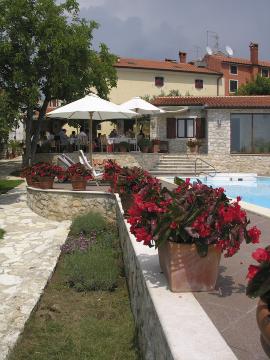 San Rocco
San Rocco
It was a hot day and the setting was gorgeous, the smart al fresco restaurant terrace of a boutique hotel, the surface of the invitingly blue swimming pool remaining unrippled because there simply wasn’t enough time by the time we’d worked our way through the many varied courses that kept arriving. Besides, anyone who had gone for a swim after the meal would have been in danger of drowning and that might have caused a diplomatic incident, so probably just as well no-one did venture in.
 Oz enjoying the Misal fizz
Oz enjoying the Misal fizz
As we did the night before, we start with a nutty, dry glass of Misal champagne-method fizz, in this case the Blanc de Blancs Chardonnay, which Oz is enjoying enormously, and not surprising. Misal is easily the best fizz we had on the trip and a full-flavoured biscuity little number that wouldn’t disgrace champagne. In fact by the penultimate night, when we were offered a choice of sparkling wines as an aperitif in the throng that assembled before the fancy gala dinner with the smartly-dressed OIV delegates, at least we knew enough by then to avoid the other fizz and go only for the excellent Misal.
The wine service was impeccable, both sommeliers bending over forwards and backwards to be helpful, but we were a party of international wine journalists, and while I can’t imagine that the service would be any less than excellent in the normal way, they were keen to showcase their wines and impress us. Which they did. Despite my disparaging remarks about sinking to the bottom of the swimming pool after the lunch, it was in fact not heavy at all and perfectly paced.
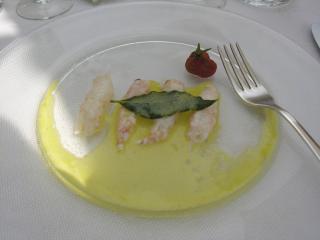 San Rocco scampi
San Rocco scampi
We began the meal with an amuse-bouche of gazpacho and ricotta, a delightfully refreshing start and much-needed in the heat of the day served with a fresh, grapey 2008 Muskat Bigeli, San Pellegrin, Degrassi. This was followed by a crisp, opulently fruity Mâcon-like 2008 Chardonnay Pilato with marinated scampi accompanied by two different kinds of salt: sea salt and savoury scampi salt, both delicious, the savouriness of the scampi salt in particular.
Next came octopus in a butter sauce. Ever since I once had octopus on a Greek island that was so tender it melted in the mouth, I have been in search of a similar, subtly-flavoured, tender octopus, but never found it. Until this moment. Arriving like the mislaid body part of a little black monster on the plate, which it was, it looked umprepossessing but tasted magnificent. We drank a pure, intense and refreshingly crisp 2008 Veralda Itsrak Malvazija Prestige.
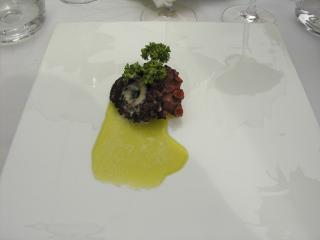 Little black sea monster
Little black sea monster
I could have stopped there, but I would have missed out on the next, Italian-influenced course of home-made ravioli and summer truffle with a cheesy / bechamel-like sauce, a wafer of parmesan and a sprig of thyme. The pasta was perfectly al dente, the summer truffle shavings plentiful and suitably whiffy, a drizzle of olive oil for lubrication: perfection with 2005 Gran Malvasia, Coronica, a powerful, barrique-aged, smoky, honeyed dry white. They do like their summer truffles, big black knobbly things with a surprisingly delicate garlicy / sexy whiff when they’re shaved wafer thin over things, especially hot things to bring out the aroma.
 Ravioli and summer truffles
Ravioli and summer truffles
So yes, more summer truffles shaved over the next course, baby squid in squid ink with potato, served for some inexplicable reason in a cocktail glass, before we moved on to an unidentified green cylinder with sprig of rosemary and reduced sauce. What was this? It was meltingly tender, slow-baked pork belly and prosciutto encrusted in crushed pistachio bits. Maybe not the greatest dish for a hot day, but there was loads of flavour there, and washed down by a perfumed, peppery and refreshingly mulberry-like 2004 Gran Teran, Istria, from Coronica, a marriage in Croatian heaven, wherever that might be.
 Pork belly rolled in pastachio nuts
Pork belly rolled in pastachio nuts
Of course there had to be two desserts, the first a lemon sunsplash on which sat a real lemon filled with a creamy, lemony chiffon-like dessert. It was light, lemony of course, and far more refreshing than the Lindt and Valrhona chocolate cake that concluded the proceedings with a richly concentrated, dried apricoty Malvasia Tavel. But by that time, resistance had gone out of the window, or would have if there’d been one.
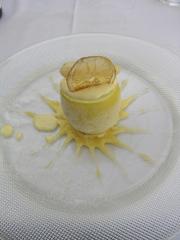 Just...
Just...
 ...desserts
...desserts
I had lost all sense of time and so it seems had our organizers Ivona and Morana, who, groaning perhaps equally under the weight of courses, eventually ushered us to our bus for a trip to Moreno Coronica’s meticulously farmed vineyards http://www.anthonyrosewine.com/journal/2009/7/croatia-part-2-istria-conn... followed by a very late tour into the Istrian hills at Ipsi for an olive oil, wine tasting and buffet supper.
After the Coronica visit, we arrived at the olive oil tasting just after sunset as there were mosquitoes still buzzing around looking for a meal of their own. We embarked on the tasting of both wine and oil before tucking into a gargantuan buffet in the hills: plates overflowing with scampi, rare beef, and a host of dishes which would no doubt had been even more delicious had we had time to digest what had gone before. I can’t recall what time we left to head back to Zagreb, but when I got to my hotel room, I was just about awake enough to notice that it was 3 am as my head hit the pillow.
After all that travelling, staying in the pretty city of Zagreb, with its twin-spired cathedral , many Baroque buildings and open markets, came as welcome respite, not that we had much time to wander around the city given that two tastings were organised for us, the first a tasting of graševina in the morning, the second a tasting of plavac (pronounced plavats) mali that afternoon.
Graševina in case you didn’t know it ( and ok I admit I didn’t) is a synonym for welschriesling (aka laški rizling, aka olasz rizling, aka vlašsky (meaning from Wallachia) ryzlink, aka riesling italico), a grape variety that’s been blamed for all the sub-standard, boring wine (think Lutomer laski riesling) that gave Germany’s rhine riesling such a bad press. It was therefore quite hard initially to get one’s head around the possibility that it might be a high quality grape in its own right.
According to our knowledgeable host, wine writer Saša Špiranec, graševina is a central European grape variety of unknown origin. No matter the precise origin, it is mainly grown in the Danube countries of Romania, Serbia, Croatia, Austria, Czech Republic and Hungary and should therefore perhaps be considered a quintessentially Danubian variety. According to Saša, its perception on overseas markets was undermined (a) because the socialist economy churned out sub-standard wines made from it and (b) because of its nominal association with riesling, with which it has nothing in common. It is apparently called graševina in Croatia because it comes from the word Grasak (which means green peas) as the berry recalls peas as it develops.
The three best locations for graševina in Croatia are apparently Baranja (loess soils close to the Danube, low yields, full-bodied), Ilok (more aromatic and fresher with higher acidity) and Kutjevo (well-balanced with juicy apple and citrus flavours), the latter a district in Slavonia where we’re heading the next day. Saša was candid about the most recent vintages, telling us that 2006 was a very good year with regular showers and sunny weather, 2007 a very hot year, the harvest several weeks early and 2008 less good than 2006 with a lot of hail in many regions at the time of harvest, but also a good year. For my notes of the graševina tasting, see below.
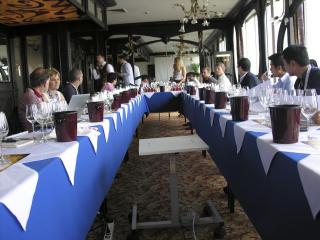 Tasting graševina - it's not all about food you know
Tasting graševina - it's not all about food you know
The afternoon was devoted to a tasting of plavac mali, an indigenous Croatian variety from mid and south Dalmatia, i.e. the coastal area of Croatia. Ampleographers, among them Carole Meredith from UCLA Davis and professors Maletić and Pejić in Croatia, found that plavac mali is a cross between two other indigenous Croatian varieties, crljenak kaštelanski with šoltanski dobričić. Plavac adapts well to the Mediterranean climate and poor rocky soils. It’s mainly grown as a bush vine with typical aromas and flavours of dark fruits such as black cherry, plum and blackberry.
One interesting quirk worthy of note is that when it comes from what are supposedly the best appellations (Dingać, Postup and Ivan Dolac), it doesn’t, note doesn’t, have the name of the grape variety on the label. It’s also rocketed in price thanks to the new demand for reds – from €4 - €5 a few years ago to €20 today. According to Saša, the best results for plavac mali are obtained on southern slopes looking towards the sea, subject to the differences in altitude and distance from the sea. Its freshness is retained when there’s cold mountain air circulating in the vineyards.
From the south heading northwards, the first important region for plavac mali is the phallic-shaped Peljesac Peninsula, where there are several major appellations, notably Dingać, Postup and Trstenik (don’t ask me what happened to Croatian vowels by the way). The island of Hvar (said to be very beautiful but sadly we didn’t have time to go there) contains the important appellations of Ivan Dolac and Sveta Nedilja. Other significant areas are the islands of Brac, Lastovo and Vis. What better excuse for island hopping then than an in-depth look at plavac mali. In the absence of that particular opportunity, I did the tasting instead, and my notes are published below.
1. Graševina tasting (prices, in euros, are approximate retail) Zagreb, morning 3 July 2009.
1. Graševina Frlan 2007. 11.7%. €3 - €4. Pale, fresh, lightly smoky, lemony citrus aromas, quite attractively juicy stonefruit and apple characters, nice freshness, with juicy bite, nicely dry and crisp on the finish, distinctive, almost austere, good length, well-made and nice steely dry acidity, a mineral quality. 89
2. Graševina Krizevacka barrique 2006. 12.5%. €7. Marked smoky barrique oak giving vanilla and oaky characters on the nose and the palate, good citrusy acidity, and quite nicely oaked although the end result is that the oak rather pokes out and detracts from the fruit freshness. 88 +
3. Graševina Zigrovic 2007. 13.3%. €6. Pleasant freshness on the nose, zippy spritz, quite nice tropical citrus fruits flavours, touches of lime, barrique works pleasantly dry and zest fruit quality with good cleansing fresh acidity and nice juicy texture. 87
4. Graševina Daruvarska 2007. 13.4% €4. Quite nice citrusy nose, rather full, rich and off-dry characters, quite earthy and rustic, interesting flavours, possible touch of raisin, melony, quite flat and broad on the back palate. 86
Kutjevo
5. Graševina Mihalj 2006. 12.6% €12 - €15. Nice freshness on the nose, peach, melon and apple, good fresh spritz despite its evolution, off-dry, nice zingy fruit freshness with apple, a really attractive juicy fresh fruit quality with melon and apple and juicy fresh acidity. 89
6. Graševina Krauthaker 2008. 13%. €6. Very nice nose, lightly smoky and aromatic, very nicely rich, textured and glossy fruit, lightly limey, with good zesty tropical citrus fruit characters, hint of apple, lovely fruit and seamless juicy character. 90.
7. Graševina Kutjevo de Gotho. Co-op. 13.4%. €6. Not 100% Graševina. Marked lime citrus on the nose, slightly coarse and musty, bit loose on the palate, diffuse. 84
8. Graševina Bartolovic 2007. 13%. €6. Slight oxidation on the nose, pleasant ripe quite rich stonefruit, appley . ?
9. Graševina Krauthaker Mitrovac. 14%. €7. Nice nose, intense, smoky, fresh spritz, richky textured fruit, appley, close to off-dry, good juicy textured, lightly smoky fruit quality, nicely fresh, crisp and dry, full-bodied, rich food wine, good intensity, feeling a little heat from the alcohol. 89
10. Graševina Adzic Hrnejevac. 12.5%. €10. Greeny yellow, very good lightly smoky, glossy fruit, stonefruit , apple flavours with a touch of off-dry honeyed richness, well made, almost off-dry, with good fresh twist of citrusy acidity on the finish. 89 +
11. Graševina Enjingikasna Berba 2006. 14.2%. €10. Almond oil bitterness on the nose and grapefruit zest, slightly odd fennel -like aromas, light spritz, and high alcohol crushed cider apple fruit with quite bitter phenolic character. Hefty and powerful. 87
12. Graševina Belje 2008. 14.7%. €5 - €6. Greeny gold, rich peachy nose, good full-flavoured richness of fruit and concentration of fruit with appley undertones, almost luscious, but good dry finish and fresh acidity just about holding this powerfully full-fruited wine together, like an Alsace pinot gris. Modern. 90.
13. Graševina Kalazic 2007. 13.5%.. €3 - €4. Deepish yellow gold, nice fresh fruit quality on the nose, dried apricot and stonefruit, spritz fresh, very good richness and concentration, with spice, baked apple, fresh acidity and a seamless fruit quality finished by refreshing minerally dry acidity and honeyed finish; lovely balance. Excellent. 92
14. Graševina Goldberg 2007. 14%. €15. Kasna = late harvest . Warm region. Greeny gold, slightly odd, slightly grubby nose, quite richly fruited and concentrated, ripe, opulent, (but slightly corked), good ripe fruit but just a bit off-dry and hefty in style, a bit clunky. Second bottle is richer and slightly better with some nice richness and honeyed fruit quality . 87+ 87.
15. Graševina Gerstmajer 2007. 12.6%. €8 - €10. Greeny fresh colour, Good fresh citrus petrol and limey citrus fruit quality, refreshingly acidity in a rich, off-dry limey citrusy riesling like wine, with very nice textured fruit, very juicy, with zest fresh acidity and nice balance. 92
16. Graševina Dvanajscak Kozo 2006. 13.9%. €7 - €8. Quite nice, fresh, slightly smoky/ limey aromas, rather big, full and richly concentrated, fruit, lovely tropical citrus, good acidity, powerful tropical citrus fruit, rich medium sweet fruit, juicy, finishing with zesty acidity and fine balance. 93
17. Graševina Darvarska izborna berba bobica 2004. 15.4%. €10 - €12.. Rich apples and honey botrytis nose, very nice richness and concentration, slippery, glossy textured fruit, powerful and with an elegant dryness that prevents it from cloying. Nice spicy fruit quality and richness, maybe just a tad too powerful for its own good, but in the line of a powerful, off-dry Alsace pinot gris. 89 +
18. Graševina Enjingi izborna berba 2004. 16%. €10 - €12. Melony nose, very powerful fruit, feel the burn. Peppery too, and spicy, but very hefty and burning dry on the back palate. Just too strong. 87
19. Graševina Krauthaker izborna berba prosusenih bobica 2007. 13%. Half-bottle. €15 Yellow gold, rich, sweet luscious apricot skin and peach nose, very concentrated and intense dried fruits concentration, lovely fresh acidity bringing freshness to a lusciously rich, honeyed and intensely flavoured but not cloying fruit style. Beautifully balanced overall. 95
20. Graševina Kutjevo ledena berba 2005. Ice wine. 12.6%. Over €50. Half. Floral rose petal-like and honeyed aromas, very rich and intense, herb, thyme, lots of essence of peach and apple, with floral undertones, fine fresh acidity, very juicy and intense, an unusual smoky quality; ba or tba. 93
2. Plavac Mali tasting, afternoon, Zagreb 3 July 2009.
Hvar – 1st 7. Hottest place in Croatia.
1. Plavac Mali Mediterano 2007. 13.3%. Sweet plum and blackberry nose, touch of oak spice, ripe plum and dark red fruits, quite firm, rustic tannins, finishing a tad dry and bitter. 86
2. Zlatan Crljenak 2006. Zinfandel. 14%. Slightly volatile nose and fruit, bit of acetic nail varnish / acetaldehyde rusticity and hard rustic tannins, short. 83.
3. Plavac Mali barrique, Andro Tomic 2006. 14%. Mulberry / strawberry jam nose, sweet strawberry and plum fruit, light smoke, sweet almost raisiny fruit quality, quite nice refreshing twist of tannin and acidity. 88
4. (Plavac Mali) Svirce 2006. 14.3%. Spicy, incensey nose, nicely perfumed fruit, firmish structure with quite extracted chunky tannins and a veneer of flattering new vanilla oak; rather aggressive finish in tannic structure and horsey hint of brett. 84
5. (Plavac Mali) Zlatan Plavac barrique 2006. 14.5%. Slightly grubby oak aromas, bretty, sweet raisiny and dark plum fruit quality, firmish, rustic tannins, but resolved at least, fair level of concentration, slightly dry finish. 86
6. (Plavac Mali) Zlatan Plavac Grand Cru 2006. 15%. Uses 70% French, 15% US and rest Croatian oak. Old vines, low yield. Very strong vanilla oak nose, sweet rich and concentrated fruit, very international style, slight feral, mushroomy character; chunky tannins. Typically impressive modern style that’s so OTT in new oak that it’s almost impossible to gauge the quality of the fruit which may well be very good, if rustic. 86
7. (Plavac Mali) Medvid. 2005. Dubokovic and Barbic. 14.8%. Quite spicy, incensy aromas, evolved, nice prune and plum richness on the palate, good concentration, dryish rustic tannins, nice touch of vanilla and spice, good juicy finish, well-crafted. 89
Peljesic
8. (Plavac Mali) Postup, Donja Banda 2006. 14%. Smoky, chocolatey, tarry syrah aromas, cool climate rhone’ish, baconfat, nice sweet fruit, quite firm tannins, but resolved. 89
9. (Plavac Mali) Plavac Libertas 2006. 13.8%. Baked raisiny aromas and superripe raisin and prune fruit with very chunky tannins and spice, bordering on controlled oxidation, chunky tannins, nice sweet middle, good intensity. 88
10. (Plavac Mali) Dingać Saints Hill 2008. 15% +. Relatively pale colour, McLaren Vale grenachey, sweet red fruits, strawberry and cherry jam, big, powerful, sweet Croatian answer to McLaren Vale or southern Rhône, nice fresh acidity, firm chunky, muscular tannins good pure fruit,, still very youthful, may turn out well. 89+
11. Dingać 2005. A slight beefstockish savoury element on the nose, quite extracted with firm, muscular chunky tannins, very chewy and chunky, meaty character, hard to see the fruit for the tannins. 86
12. Plavac Mali Korta Katrina 2006. 14.2%. Modern style, sleek, polished, nice cedar , incense and sandalwood oak, very nice fruit quality, dark fruits, damson, plum, very nice fresh fruit quality, juicy and spicy at the same time, with fine tannins and refreshing acidity. 90+
13. (Plavac Mali) Dingać Madirazza Reserva barrique 2006. 14.7%. Good colour, sweet cherry jam and vanilla nose and nice rich fruited cherry and mulberry palate with good fresh savoury acidity and firmish but nicely resolved balancing tannins. Well-made, stylish wine with very good fruit quality and nice freshness in modern style 90+.
14. (Plavac Mali) Dingać Milicic 2006. 14.1%. Very nice aromatic, incense spicy, smoky vanillan and cedary aromas, very attractive, nice loganberry-like, concentrated sweet fruit quality, almost a pinot / grenache crossing; quite chewy, textured rough and rustic tannins, but evolved and juicy sweet fruit. Really good. 90+
15. (Plavac Mali) Dingać Skaramuca Reserva 2006. 14.7%. Evolved nose, spicy, some savoury characters, quite chunky and extracted fruit, doesn’t allow much time for the fruit to speak, rather drying on the finish. Powerful, needs food. 88
16. (Plavac Mali) Dingać Matusko Reserva 2004. 14.8%. VA, Very deep colour, baked sweet, spicy, porty nose and similarly pruney dark baked sweet spicy fruit on the palate, lots of damson juiciness with slight volatile, dry, port-like characters. Big, powerful, porty and chunky, a tad four-square and mono-dimensional but a grand dimension. 87
17. (Plavac Mali) Milos Stagnum 2003. 14.6%. Slightly evil, fecal, goblin-like aromas, ditto on palate, very chunky tannins, dry, dry, dry and chewy. Bretty. 80
18. (Plavac Mali) Dingać Kolekcija 2004 (bottled in 2006). 14.3%. Nicely evolved aromas and colour, some grenache like red fruits sweetness tempered by good savoury acidity and softened tannins, no evident oak, nicely made and approachable now, like an opulent Vacqueyras. 88+

